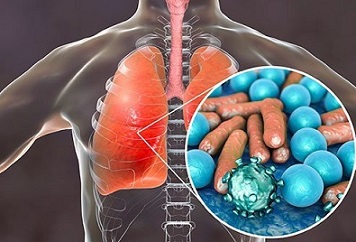Ohio State University Murine Study Surprisingly Discovers That Tuberculosis Infection Induces Resistance To Secondary COVID-19!
Source: Medical News-SARS-CoV-2 Research Nov 15, 2021 4 years, 1 month, 1 week, 3 days, 1 hour, 36 minutes ago
Researchers from Ohio State University-USA have in a new murine study surprising found that Mycobacterium tuberculosis may induce resistance to secondary SARS-CoV-2 infection.
 Mtb or Mycobacterium tuberculosis
Mtb or Mycobacterium tuberculosis and CoV2 or SARS-CoV-2 are both leading pathogens that causes an infectious disease that sometimes lead to death.
Both are distinct organisms which both cause lung disease ie one is a type of bacteria while the other is a virus.
Though Mtb and CoV2 both cause serious and sometimes fatal respiratory infections, the effect of Mtb infection and its associated immune response on secondary infection with CoV2 is unknown.
In order to address this issue, the study team applied two mouse models of COVID-19, using mice which were already chronically infected with Mtb.
Surprisingly, the study findings showed that in both model systems, Mtb-infected mice were resistant to secondary CoV2 infection and its pathological consequences, and CoV2 infection did not affect Mtb burdens.
Single cell RNA sequencing of coinfected and monoinfected lungs demonstrated the resistance of Mtb-infected mice is associated with expansion of T and B cell subsets upon viral challenge.
The study findings demonstrate that Mtb infection conditions the lung environment in a manner that is not conducive to CoV2 survival. The Mtb-infected mice were found to be resistant to secondary infection with CoV2, with no impact on Mtb burden and resistance associating with lung T and B cell expansion.
The study findings were published on a preprint server and is currently being peer reviewed.
https://www.biorxiv.org/content/10.1101/2021.11.09.467862v1
The study findings clearly show the effect of
Mycobacterium tuberculosis infection on the pathogenesis of severe acute respiratory syndrome coronavirus 2 (SARS-CoV-2) infection as it revealed that that mice infected with
mycobacterium tuberculosis are resistant to SARS-CoV-2 infection. This resistance is induced by expansion of T- and B-cell subsets in the lungs upon secondary viral challenge.
The Mycobacterium tuberculosis bacteria is a pathogenic organism belonging to the family Mycobacteriaceae. Like SARS-CoV-2, the causative pathogen of coronavirus disease 2019 (COVID-19), Mycobacterium tuberculosis causes severe and often fatal lung infection called tuberculosis.
Sadly, both tuberculosis and COVID-19 are associated with high mortality rates in humans.
Corresponding author Dr Richard T. Robinson from the Department of Microbial Infection and Immunity at The Ohio State University told Thailand
Medical News, “There is evidence suggesting that the mortality rate of COVID-19 is relatively low in countries where tuberculosis is prevalent.”
The study team investigated the clinical consequences of Mycobacterium tuberculosis and SARS-CoV-2 co-infection in mice.
The study team developed two mouse models of COVID-1
9 using mice that were chronically infected with Mycobacterium tuberculosis. To this end, human angiotensin-converting enzyme 2 (ACE-2)-expressing mice were infected with low-dose Mycobacterium tuberculosis via aerosol-based delivery.
Subsequently after 30 days, secondary SARS-CoV-2 infection was induced in these mice through the intranasal route.
The study team then assessed the clinical consequences of co-infection at days 4, 7, and 14 post-viral challenge. The controls in this study were mice infected with either Mycobacterium tuberculosis or SARS-CoV-2.
Interestingly the highest reduction in body weight was observed in mice infected with only SARS-CoV-2. However, co-infected mice did not show any significant body weight loss and were comparable to mice infected with only Mycobacterium tuberculosis.
Also, a significantly lower lung viral load was observed in co-infected mice compared to SARS-CoV-2-infected mice. Moreover, no change in the growth of Mycobacterium tuberculosis was observed in the lungs, liver, and spleen after the viral challenge.
It was observed that the challenge of mice with SARS-CoV-2 caused a significant increase in the levels of proinflammatory mediators including interferon g (IFN-g), interleukin-6 (IL-6) and IL-1b. Mice infected with Mycobacterium tuberculosis only exhibited even higher levels of inflammatory mediators in the lungs.
Most importantly, the levels remained unchanged upon challenge with SARS-CoV-2. The resistance of Mycobacterium tuberculosis-infected mice to SARS-CoV-2 was not associated with an elevated expression of anti-inflammatory mediators.
Pertaining to the observed histopathological changes, SARS-CoV-2-infected mice showed significant levels of alveolar necrosis and infiltration of proinflammatory mediators. A significantly higher level of pneumonia and hyaline membrane formation was observed in the lungs of SARS-CoV-2-infected mice.
However, these changes were not seen in the lungs of co-infected mice.
The study team noted that the viral resistance due to Mycobacterium tuberculosis infection observed in ACE-2-expressing mice was also observed in mice infected with mouse-adapted SARS-CoV-2.
Importantly immune cells isolated from the lungs of mice infected with mouse-adapted SARS-CoV-2, Mycobacterium tuberculosis, or both were subjected to single-cell ribonucleic acid (RNA) sequencing to determine the mechanism of Mycobacterium tuberculosis-induced viral resistance.
Surprisingly the findings of RNA sequencing revealed that the immune environment in the lungs of co-infected mice was similar to that observed in the lungs of Mycobacterium tuberculosis-infected mice, with the exception of expanded B-cell and T-cell subsets.
The study findings reveal that mice infected with Mycobacterium tuberculosis are resistant to secondary SARS-CoV-2 infection and COVID-19-related pathologies. To this end, the Mycobacterium tuberculosis infection appears to create an inflammatory microenvironment in the lungs, which is unfavorable for SARS-CoV-2 propagation.
The study team said that the presence of a wide variety of innate immune cells due to Mycobacterium tuberculosis infection may prevent SARS-CoV-2 infection.
Furthermore, Mycobacterium tuberculosis-induced adaptive immune response may cross-react with viral antigen to induce resistance. The expansion of B-cell and T-cell subsets after the SARS-CoV-2 challenge supports the explanation of Mycobacterium tuberculosis-induced SARS-CoV-2 resistance.
For the latest
SARS-CoV-2 Research, keep on logging to Thailand Medical News.
